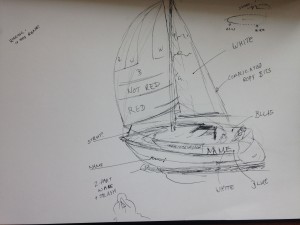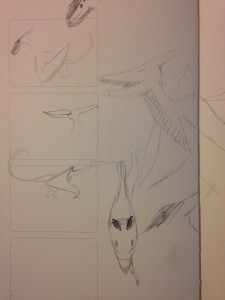|
 Part of the process of making a painting is working out what will go where. Part of the process is working out what shapes it will be, and how the shapes interact. Sketches help with both of those. The first sketches I make are to find out what is going to be difficult, and how to simplify or complicate different parts. Part of the process of making a painting is working out what will go where. Part of the process is working out what shapes it will be, and how the shapes interact. Sketches help with both of those. The first sketches I make are to find out what is going to be difficult, and how to simplify or complicate different parts.
This boat is an extreme version of my sketching, where I am making notes inside outlines. Usually I sketch tonally with areas of darkness being the important bits, but in this case I needed to work out proportion, and there was not enough information in the photograph I was using to start a tonal picture. Once I had the sketch, I could place the picture more accurately on the canvas, as I had the shape in my head.
I generally start with thumbnail sketches, a set of very small pictures that determine how the biggest parts of the picture will look. If you back up far enough, the finished picture will look like the thumbnail. This may be the first thing that the client will see, and if that is the case, I will produce several different versions, to see which one they like. After the thumbnails, I will produce other sketches, for my own understanding of the subject. This is the stage at which things like the ink boat are usually produced. If the client is unsure which thumbnails are best, I will produce larger pictures, generally watercolour. These can be postcards, or larger. Eventually we will have narrowed down what they want, and how to do it.
 I have a book dedicated just to thumbnails. It is for storyboarding and has room inside the fold for larger pictures and notes, which I find hugely useful. Although I don’t always use it, it keeps the beginnings of my projects together, so I can look back and remember which ideas went well and which simply stopped. Some of the ideas get worked over a few times. These pterodactyl dragons will only be painted if someone wants me to, but drawing them helped to seal them into my mind, and let me work out the kinks and get onto the next thing. I have a book dedicated just to thumbnails. It is for storyboarding and has room inside the fold for larger pictures and notes, which I find hugely useful. Although I don’t always use it, it keeps the beginnings of my projects together, so I can look back and remember which ideas went well and which simply stopped. Some of the ideas get worked over a few times. These pterodactyl dragons will only be painted if someone wants me to, but drawing them helped to seal them into my mind, and let me work out the kinks and get onto the next thing.
The sketches of various sorts stay by my easel, to remind me of which parts of the painting are going to be difficult, which shortcuts or flights of detail I need to remember, and the overall shape of the piece. It generally needs to retain the impact of the thumbnail, while being detailed inch to inch. Sketching is a valuable part of the process because it means I know before I paint how hard it will be to complete something. It is an approximation of the work itself – a sort of estimate.
|